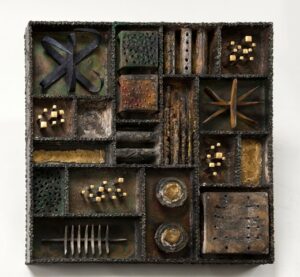Sculpted Steel Wall Collage by Paul Evans

Paul Evans, Sculpted Steel Wall Collage, 1970. Welded and patinated steel, colored pigment, gold leaf , 24 x 24 x 4 inches, James A. Michener Art Museum, Gift of the John R. Eckel, Jr. Foundation.
About the Artwork
Beginning in 1952, Paul Evans showed his work at America House, an influential New York venue for American craftsman to sell their work. There Evans started with the sales of his early pewter and silver work. Between 1961-65, his metal collage designs were featured on the front of the America House catalogue. Gaining the attention of the design industry, the exposure became a starting point for his collage design. Each featuring many box-like compartments, the design is reminiscent of old printer’s type boxes. Evans uses each division to house a variety of metal shapes, including both organic and geometric forms, all highlighted through texture and variation in color. In fabricating these works, heavy oil pigments were treated with heat and acids to create crusty-textured, multicolored surfaces.
In the mid-1960s, Evans created a steel front room divider, a forged front cabinet, and a pair of doors using similar designs. In the early 1970s, Evans created several sculpted panels with this similar theme. Approaching furniture as abstract composition and as sculptural construction, Evans uses an aesthetic of processes and surfaces that is both controlled and accidental.
In his collage designs, Evans showed possible influences from other artists. The use of found objects arranged together make reference to the work of assemblage artist Louise Nevelson. Evans used a variety of interesting found objects and purposefully arranged them in each section of the sculpture.
Looking Questions
- What do you see in this work? List all of its details.
- What is collage? How is Evans using the idea of collage in this artwork?
- How does the artist draw you in to the artwork? Is there a focal point? Explain.
- Describe the various textures found in this work. How many can you find?
- Find the shapes in this artwork. How would you describe them?
- Explain the artist’s use of repetition and pattern in this work.
- How is Evans creating balance? What elements contribute to this principle? Explain.
- What do you think could have been an inspiration for this artwork?
Activities at Home
- Inspired by Evans’s Sculpted Steel Wall Collage, collect found objects from nature like a twig, a leaf, a bone, a rock, a feather, a pine cone, etc.. Draw a detailed study of each object separately. Draw a box around each individual object, cut out each box and collage all of them together to create one drawing. Add colors like Evans did to highlight the objects.
- Where do you think artists get their inspiration? Research the work of artists that incorporate found objects into their artwork like Louise Nevelson. Note the differences in each approach.
- Take note of the balance of organic and geometric shapes the artist utilized in his work while viewing the online exhibition. How are the combination of shapes important? Draw the shapes you see in your sketchbook.
- Make your own wall collage by using a collection of objects that relate in some way to each other. Glue each object onto a large square piece of heavy cardboard. Between the objects, glue narrow strips of cardboard to the back for dividers horizontally and cut slits in the cardboard to add pieces vertically. Add pieces along the outside edges to frame the box. Paint all of the objects and box the same color. Then create a metal patina effect by sponge painting earth tones over the objects.
- Find three objects in the Sculpted Steel Wall Collage. Draw an enlarged detailed drawing of each on separate paper. Write one paragraph that tells a story about each object.
- Arrange and glue a group of found objects on a large piece of paper and think about their various textures. Do a rubbing of the arrangement using a thin piece of drawing paper. Using perspective, draw a three-dimensional box around the rubbing. Add color to enhance and define the objects.
- Visit the online exhibition, Paul Evans: Crossing Boundaries and Crafting Modernism. Find the other Wall Collage and compare and contrast it the one featured on this page. What similarities and differences can you find? Write down all of your findings. Which one do you like better? Why?
- Find all the works in the online exhibition that are from the same collage design series. How many different pieces of furniture can you find? How are they similar? Different?
- Download more activities here.
Related Resources
- Visit the online catalogue on Paul Evans and view a video from the exhibition, Paul Evans: Crossing Boundaries and Crafting Modernism.
- See Sculpted Steel Wall Collage by Paul Evans on Google Arts and Culture.
- See Sculpted Steel Wall Collage by Paul Evans on the Michener Art Museum’s Mobile App.
- Learn more about Paul Evans on the Bucks County Artists’ Database.
- Activity Sheet: Sculpted Steel Wall Collage by Paul Evans (.pdf)
- See a Documentary on Paul Evans on the Michener’s Vimeo Channel.
- Listen to the Paul Evans: Crossing Boundaries and Crafting Modernism Audio Tour.
- Learn more about Phillip Lloyd Powell, another artist who collaborated with Paul Evans.